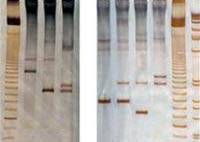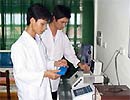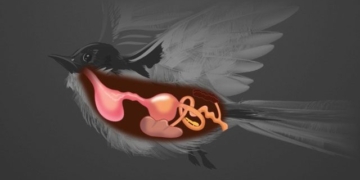For 17 years, Professor Le Dinh Luong has conducted DNA tests for hundreds of people, encountering many complex relationships where DNA technology was needed to identify familial connections such as father-son or sibling relationships. The majority of clients have been long-distance drivers, company directors, and some officials who have been “falsely accused.”
 |
Two “gene” charts displaying DNA images and the blood relationships of parent-child pairs |
In a small apartment located in the Vinh Phuc collective area (Ba Dinh, Hanoi), arranged like a general clinic, a man in his thirties entered with a 3-year-old child. He sat down, hesitantly pulled out his ID and a request form, placing them on the table. Professor Luong, the founder of the DNA Analysis and Genetic Technology Center (affiliated with the Vietnam Union of Science and Technology Associations), read the form and asked, “Do you need a DNA test to confirm if this child is really your son?” The man nodded, his face revealing a troubled expression.
After a moment, he spoke up: “Professor, I’ve come here to escape from my wife. Please keep this confidential and provide me with an accurate result, so I can know if this child is truly mine.” Professor Luong looked him in the eye, expressing empathy, and said: “Rest assured. Even if you offered me money to alter the results, I would never do that. To me, the truth must remain the truth.”
Seeing the kind face of the professor, who had spent decades immersed in science, the man felt more confident and recounted: “Since this boy was born, I have often doubted he is my ‘product.’ The reason is that during the time we were preparing for our wedding, my wife was still involved with her ex. My family life has been incredibly chaotic over the years.” His story continued until nightfall.
Two nurses stepped out to collect blood samples and cells from the father and son, dried them, and placed them in two envelopes. Professor Luong personally labeled each small envelope with a code before placing them into a larger envelope. The father and son quietly left, holding an appointment slip to return for results in 10 days.
The testing was conducted at a secret location in the center of Cau Giay District (Hanoi), where the samples from the man and child would be processed by seven staff members in an analysis room.
He gently pressed a button, and the machine lid opened. Inside, 96 small plastic wells, resembling children’s fingers, were aligned evenly. Pulling one well out, he explained that the DNA samples from clients would be placed into these wells after extraction. Each test pair requires 2-3 samples: father-mother-child or father (mother)-child.
 |
Two staff members from the DNA Analysis and Genetic Technology Center are placing cell samples into the PCR machine |
Just three hours later, the machine can provide results, but he stated: “I have to tell clients to wait ten days for their results, partly because there are many samples to test. Also, if the DNA results indicate that the child is not biologically related to the father or mother, we have to repeat the tests multiple times to ensure there are no mistakes.”
Throughout the testing process, the client’s gene segments are rapidly amplified. Thanks to the electrophoresis process (which separates long and short gene segments, enhancing resolution), the “information” on each selected gene segment is “read” and transferred to the DNA dyeing procedure. Images of the gene segments and DNA structures are printed on paper for verification and comparison, referred to as “gene” charts.
Different lengths of DNA segments are clearly visible on the “gene” charts and can be distinguished with the naked eye. Thus, it can be accurately determined whether a child is the “product” of both parents, only the father, only the mother, or neither based on DNA principles and genetics.
Professor Luong believes that the “gene” charts are undeniable evidence of the truth.
Just three hours later, on the DNA dyeing section, the “gene” chart of the young man’s father-son pair was clear as a freshly developed film. Two DNA columns aligned with two pink bands lined up perfectly. “This confirms that this child is his son,” Professor Luong pointed to the pink band and concluded.
“And this result confirms that this child is not the biological offspring of the father, a private company director from Ho Chi Minh City who just flew in to meet me,” he pointed to a stack of “gene” charts still wet with ink, flipping through the pages while explaining.
“Here, the third pink band is not aligned with the first and second bands. It indicates that this child is not the biological child of either parent, a couple from Hanoi.”
However, he affirmed, “Regardless of the results, I must tell them the truth. First, I have a duty to inform them of the truth. Science is meant to reveal the truth. Second, the truth cannot be hidden forever.”
Professor Luong noted that recently both PCR machines have been operating 24 hours a day. The reason is that the number of clients seeking DNA services is steadily increasing. On average, the center performs one DNA test each day, with most clients being male, and the majority resulting in father-child relationships with shared bloodlines. “This indicates a troubling truth: many husbands unfairly accuse their wives,” he noted. Of course, he revealed that out of every 100 cases, there are about 15-20 where the father and child are not biologically related.
Pulling out a file from a cabinet, he recounted: “Over the past 17 years, having directly received and tested DNA for hundreds of individuals, I have come to realize that our modern society is giving rise to increasingly complex relationships. With each test case, I gather stories of profound personal struggles, often moving enough to bring tears to my eyes, and I could write a book with 1,001 life stories.” He mentioned plans to compile these 1,001 stories by the end of 2006.
There are many reasons and circumstances that lead people to seek his center for testing. For instance, at the request of the court, or during the war when siblings, parents, and children became separated and lost. Now, they reunite but are uncertain if they share the same bloodline. Additionally, during the war, some American, French, and Japanese soldiers left behind illegitimate children in Vietnam, and now they seek to trace their lineage.
However, the most common clients are long-distance drivers, company directors, and certain officials. “Directors often have many secretaries. Over time, secretaries often bring children to claim paternity. No one can confidently assert that a child is the ‘result’ of that director except for DNA evidence,” he said.
Thanks to DNA testing, he has witnessed many “bosses” from Hanoi, Hai Phong, Nha Trang, Vung Tau, and Ho Chi Minh City exclaim: “So I have to support this little rascal?” This is also why he moved the testing lab to a secret address, as many clients have pleaded with his staff to provide them with false results (indicating no shared bloodline). Conversely, he has often helped clients expose extortion schemes by women.
Regarding the “gene” charts that indicate a child is not a “product” of either parent, he explained that this suggests those children are adopted, often due to being mistakenly swapped at the hospital. “Such cases are not rare these days.”




















































